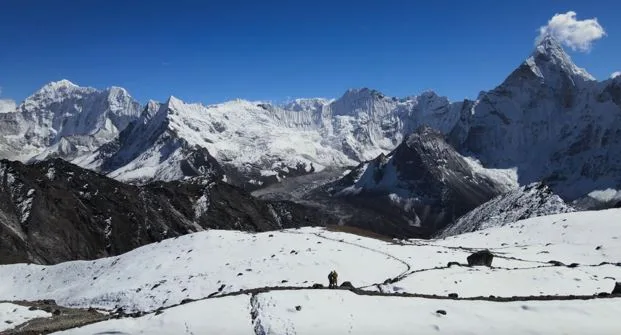Combining Island Peak Climbing with Everest Base Camp: A Journey through the Khumbu Region
For adventure -seekers, the famous Everest mountain and Khumbu region in Nepal is a dream come true. One of the best ways to appreciate the rugged high altitude terrain is to combine Island Peak climbing with EBC trekking.
Your journey starts with a mount Everest challenger peak and puts you at the foot of the world’s highest- Mount Everest, making it a once in a lifetime experience. This combination is ideal for those who wish to experience the beauty laden Everest region’s sceneries along with summiting a Himalayan peak.
So, let’s discuss in-depth what makes this journey special. It’s reason enough to put it at the top of every adventurer’s wish list.
The Island Peak Climbing Experience
Located in Nepal, Island Peak at 6189 meters is one of the highest altitude climbs in Nepal. Island Peak contributes to its popularity for being one of the easiest Gateway Peak in the World. The trekking radial of khongar glaciers creates the breathtaking view which makes Island Peak very attractive.
It is named so due to the reason that it looks like the peak is an island in the sea of ice – And is surrounded by a spectacular view of towering himalayan island lapstones of sea. As a practice, Island Peak climbing is regarded as a non-technical climb which means advanced mountaineering skills are not necessary.
But some level of technicality such as the use of crampons, ice axes, and ropes does exist which makes it relatively easier for those seeking experienced high-altitude climbing without sophisticated skills. Completing the summit requires strength, stamina, and mental toughness which adds to your Everest Base Camp trek.
Why Combine Island Peak Climbing with Everest Base Camp
Merging these two climbs offers a good approach to crystallize the first EBC trek and Island peak climbing challenge. This presentation allows trekkers to fully optimize the trekkers when trekking for Everest Base Camp before the technical challenges of the island peak.
Undoubtedly, one of the most famous places on this earth is Everest Base Camp. During the Everest Base Camp for the trek, the stunning views of Mount Everest and its neighboring peaks, Lohtse, Napse and Pumori are clearly visible.
In addition, the region offers an opportunity to learn about Sherpa culture and praise the Tengboche monastery. The EBC’s visit also helps in adopting a mountaineer’s body properly in preparation for high height climbing for the island peak.
The average trekker spends about 12 to 14 days in the base camp. During this time, they try to maximize their height while taking adequate rest to customize their body before trying their body to a peak.
The Journey to Everest Base Camp
The Everest Base Camp begins with a flight from Kathmandu to Lukla, where the trekker is treated for the dynasty of the heart race in Lukela, one of the world’s most spectacular airports. The adventure step begins with a downhill flight.
From Lukla, trekkers will be set on foot through the Sherpa villages of fakeding, names market, Tengboche, Dingboche and Khumbu Valley, which are all in the way for the Dudh Koshi River. These villages are different in their own way, and Sherpa is rich in history.
Moreover, Everests” is considered the “Gateway to Everest” which is the largest town in the region serving as the perfect spot for rest, acclimatization, gleeful admiration, and great views for Everest and other stunning peaks in the surrounding area.
The last stop before EBC: Gorak Shep, also a landmark for everyone who goes to Everest Base Camp, after which the trekkers go through their final push for challenging the EBC, so that they can have a panoramic view of the peaks walls as well as Khumbu icefall that surrounds it.
Everything said, the trek to Everest Base Camp is not only focused on the destination but rather the entire journey itself. It’s feeling the fresh cold breeze, gaining insights into the Sherpas way of living, and soaking all of the beauty the landscape offers at the same time.
Everest base camp (Photo: Above the Himalaya)
Climbing Island Peak: Training And Adaptation Steps
The primary reason why most climbers intend to combine Island Peak climbing with EBC, is for the reason that the trek to Everest Base Camp is excellent for acclimatization and preparation prior to the actual climbing.
The gradual increase in altitude enables effective adjustment to lower oxygen levels, reducing the chances of altitude sickness, which is very common at these heights. The preparation helps not only in the acclimatization process, but also helps aid in getting the required clearance to prepare for the climb both mentally and physically.
By the time you reach Dingboche, you will have gotten some time greater than 4,000 meters on the clock, which is important for facilitating an attempt at Island Peak. There are more days of rest and light activity after reaching Everest Base Camp, these days are kept before the technical climb to ensure both mental and physical readiness for the task ahead.
The Ascent of Island Peak Climbing
It marks the final stage of the trek, after going to the Everest Base Camp, you move towards the island peak base camp, set to 5200 meters, this is the place where your climb begins. The island peak usually climbs over a period of two days, the first day is used to climb on the peak, and the second day is used to return to the base camp.
The ascent requires dealing with tiresome sections of rocky terrain, ice slopes, and a glacier. The last bit is the steep, technical climb, where crampons, an ice axe, and fixed ropes will help you reach the top.
One of the most gratifying parts of the climb is the view from the top and the feeling of achievement that comes with it. Khumbu’s amazing panoramic view during the Everest, Lhotse, and Makalu’s islands of pride will be visible at a distance.
The Descent and Return Journey
After climbing the island peak, you will return to look. There is less trouble than the trek climb, and here, you will find a place to think and enjoy the surprising sites of mountains and valleys.
Completing the hike from Everest Base Camp to Lukla brings you a nice feeling of finished completion after having done the trek to EBC, alongside the strenuous trek of climbing Island Peak and challenging climb of Island Peak.
In comparison to the physical exertion needed during the descent, you will get to appreciate the beauty of the culture by observing the villages and landscapes from the start towards the summit.
Getting Ready Physically and Psychologically for the Trip
“Mental and physical work is essential when combining Island Peak climbing and Everest Base Camp”. Trekking and climbing are usually accompanied with varying altitudes, shifting weather conditions, complex terrain, and even extreme weather.
Design an individualized program that incorporates both strength and endurance training, with particular emphasis on cardio, core, calves, and thighs. Without a doubt, preparing yourself mentally is just as important, if not more than being strong mentally and having the ability strong enough to deal with lots of physical strain trek and climb would put you through.
Consult with a professional guide or tour operator who is knowledgeable about the area, its beauty, secrets, and its risks will be a great relief when planning and assigning how and what to do with training and logistics, as sub professionally planning can really add ease and professionalism to the whole adventure.
With a guide, preparing for the climb becomes easier, and allows them and you to focus greatly on ensuring safety and success during the intense challenge.
The Final Verdict
Climbing Island Peak along with the Everest Base Camp (EBC) trek is probably one of the most multi-faceted and rewarding experiences you could ever do, having features of both trekking and mountaineering.
Summiting Island Peak translates into a Southeastern Voyage where a climber gets the opportunity to fulfill two dreams simultaneously, which is reaching the Base Camp of Mount Everest and admiring an exotic view from a ladder of an Island Peak.
Every explorer can embrace the cultural heritage of the Khumbu region as well as the physical rigor of climbing Island Peak. With realistic goals and correct preparation, one can ensure this experience will be a once in a lifetime trip.





